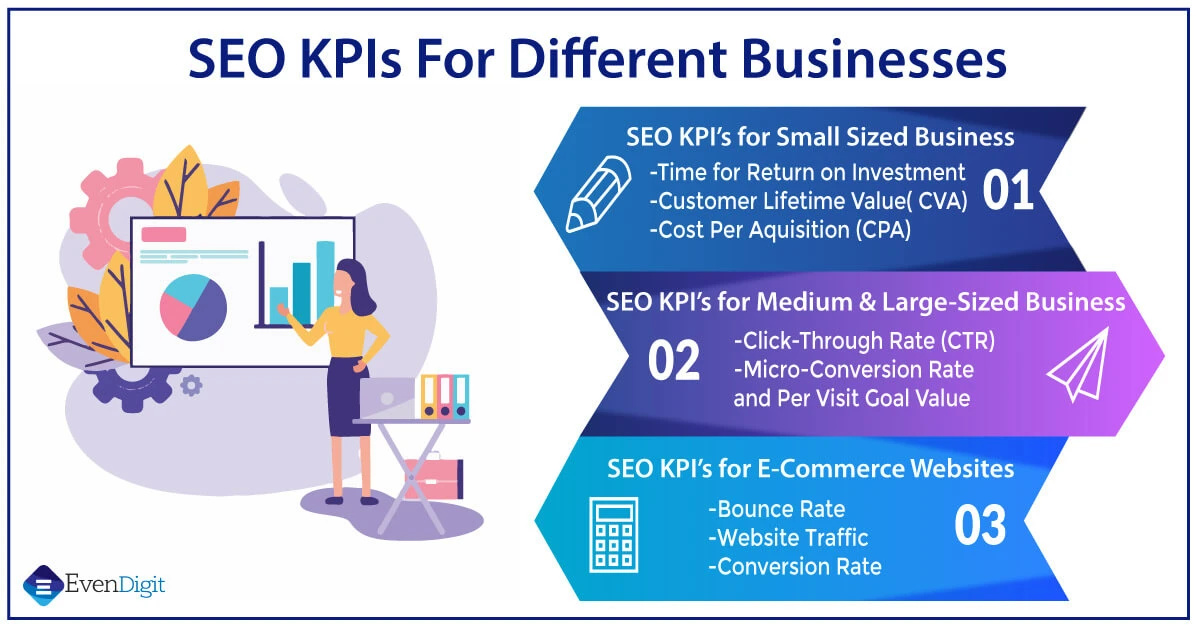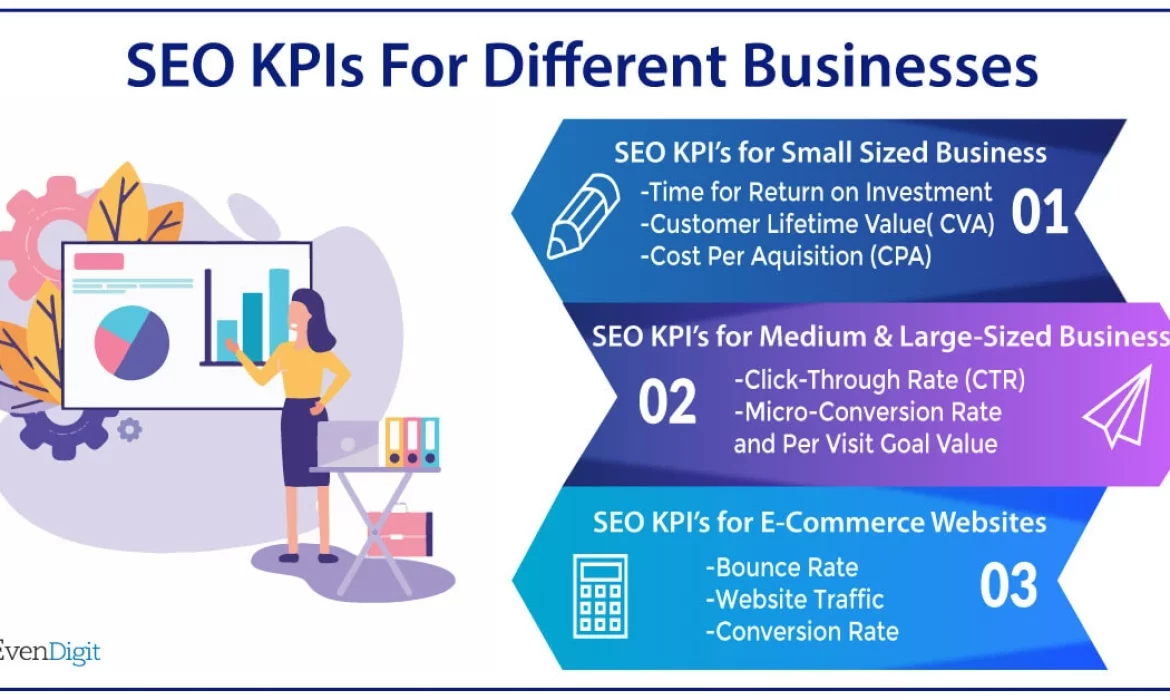
KPIs depict facts and figures which are measurable and hard to ignore in the first place. Is your website performance-driven and helps you to achieve your goals? How would you know, it’s these website KPIs which help you track the performance of your website. KPIs are essential for any business organization regardless of its size because it provides context to the goals and places accountability on the team to achieve these goals.
Every business should use digital marketing KPIs to track and measure digital marketing initiatives against the set goals. So Let’s get started with the important KPIs for 3 different businesses:
| Business Type | KPI | What to Measure | Advantages |
|---|---|---|---|
| Small Sized Business | Cost Per Acquisition | Actual Cost of Each Customer | Avoids Wasteful Expenditure |
| Customer Lifetime Value | Revenue that each customer brings during his relationship with your business | Know ROI and allocate resources | |
| Time for Return on Investment | Time a marketing campaign takes to reap positive results | Strategic management of time and website | |
| Medium-Large Sized Business | Click Through Rate | Whether your customer’s query matches your ad intent | Optimize and restructuring of content |
| Disribution of Page Depth | Percentage of visitors who visit a couple of pages of your website | Helps categorizing the pages in a better way | |
| Micro Conversion Rate & Per Visit Goal | Which ad campaign brings better revenue | Understanding economic value of each customer and determining exact place to focus | |
| E-Commerce Website | Website Traffic | Source of the website traffic from where the traffic is coming | Helps to know where to target your audience |
| Conversion Rate | To evaluate the path to purchase | Improve the way you lure your audience to buy more | |
| Bounce Rate | evaluate the percentage of visitors who leave your website after arriving from referral source | Remove irrelevant content and use better keywords | |
| Cost Per Conversion | Evaluate the amount you pay to convert a visitor into a buyer | To better plan for proper pricing, advertising and marketing your business online | |
| Cart Abandonment Rate | To evaluate percentage of shoppers who add items to cart but never buy | Helps solve issues in the checking process |
SEO KPI’s for Small Sized Business
If you don’t know how to measure the performance of the website? Here are the 3 critical KPIs to give you a clear picture of your digital marketing campaign:
1. Cost Per Aquisition(CPA)
What is the cost of earning a new customer? This is the important question CPA seems to answer and forms an important SEO metric. You can extend this metric to understand the actual cost of each customer that you acquire through each lead and click; rather than looking at the conversions and total customers.
CPA sets a benchmark whether a facebook campaign, an email initiative, or a whitepaper was worth the investment or not. This helps you to better plan your marketing efforts to avoid wasteful expenditure that brings down your CPA altogether.
2. Customer Lifetime Value(CVA)
Your customer lifetime value is another picture of your cost benefiting equation. It tells you how much to expect from an average customer in terms of revenue.
You would get to know the exact revenue that each customer brings to your business. For instance, premium membership taken by your subscribers would let you know the subscriber’s lifetime value.
This way, you can understand the ROI of your marketing efforts and how successful you are at retaining your customers, which helps you to allocate resources better to make sure you grow sustainably.
3. Time for Return on Investment(ROI)
When it comes to digital marketing, everyone wants to see results quickly, so consider how much time it takes for your business to see positive results online that makes for the third essential KPI.
If you go for inbound marketing; probably you won’t see immediate results and may get tempted to turn towards more immediate measures such as PPC campaign. However, you must remember that successful strategies require time.
So, be patient and try to understand how long it takes until a cost becomes a positive investment for your business. If it is longer than usual then, that’s an indication to come up with more relevant content. This will help you plan smarter and better for your website.
SEO KPI’s for Medium-Sized Businesses
Now if you own a medium-sized business then, here are the optimal website KPI’s for you:
1. Click-Through Rate(CTR)
CTR is something that influences your quality score and affects your ROI. When we talk about customer acquisition, an increase in CTR would automatically lower the rate of CPC. Your CTR represents the creativity and relevance of your content, affiliate deals, and banner ads. If the user query matches your ad’s intent, it is undoubtedly going to give you higher CTR. A medium-sized business needs to know the CTR as it provides an idea of what to show in the first place. You can also go for catchy subject lines for your email campaigns to see a massive improvement in your CTR.
2. Distribution of Page Depth
When it comes to important website KPIs, distribution of page depth is one that represents the percentage of visitors who visit a couple of pages at your website. You can proceed with categorizing your visits into abandoners, flirts, browsers, and loyalists that changes the way content is consumed.
Moreover, if you are running a content-only website, visiting more pages would equal to more ad impressions that will influence sales and conversions in the end.
3. Micro-Conversion Rate and Per Visit Goal Value
Usually, less than 2% of the visitors are converted and focusing on this 2 % of the visitors would help in realizing the greater economic value. When it comes to per visit goals, it enables you to think beyond that 2% of the visitors. You need to understand that every visitor may not get converted into an actual customer, but, it will deliver some economic value in the long run.
Apart from this, this SEO metric also helps in determining where you should focus. Supposedly, your Facebook page gives you a revenue of $1 accounting for your per visit goal and Google delivers $3 then; you should focus on your SEO strategies.
SEO KPI’s for E-Commerce Websites
E-Commerce KPIs can be numerous but, tracking the right ones for our business depends on its specific needs. Check out if your eCommerce SEO company is considering the below following website performance metrics that you need to consider:
1. Website Traffic
More website traffic doesn’t guarantee more purchase but, 5 % conversion rate at every 1000 visitors Vs. 1,00,000 means a lot. Website traffic not only increases purchases but relates to brand awareness.
You can use Google Analytics to monitor your website traffic where you may get the referrals to check from where the traffic is coming, is it any other website or your own social media network? Knowing who’s sending you much traffic helps you better target your audience.
2. Conversion Rate
A high conversion rate indicates you are convincing your audiences at large. Knowing your buyers would help you improve your performance and lure visitors in the sales funnel. While increasing your conversion rate, you are advised to ask a few questions:
What is the average conversion rate in my industry?
Is pricey products the reason for my low conversion rate?
Are my customers happy to buy from stores rather than the website?
What are the easy ways to quicker conversion?
You can opt for conversion rate optimization to evaluate the path to purchase and improve conversion rates.
3. Bounce Rate
It indicates the percentage of visitors who leave your website after arriving from a referral source. A high bounce rate may indicate the presence of irrelevant content as your visitors aren’t able to find what they want. For instance, your E-Commerce store sells “flared skirts”, and you have focused on the keyword “skirts.” It’s a broad keyword, and if most of your visitors are women looking for pencil skirts then, you can understand where your bounce rate will go.
Consider long-tail keywords in your SEO strategy such as “Flaired Skirts for Women” probably you would see fewer bounces.
4. Cost Per Conversion(CPC)
CPC is the amount you pay to convert a visitor into a buyer. It helps you better understand how to price your products, what to pay for advertisements, and how to market your business online.
For instance, you run a PPC ad that pays 5 cents per click, which receives 50 clicks before conversion. Your CPC averages to $2.50 that means you earn a profit if the purchase is beyond $ 2.50. Well, you also need to consider the time taken to set up an ad campaign, the cost to ship the product, and the time taken to develop the service and products.
Isn’t it complicated? Still, it’s essential to know about your average CPC.
5. Cart Abandonment Rate
It refers to the percentage of shoppers who add items to their cart but, never actually purchase. Well, it has nothing to do with your website SEO but, shoppers tend to abandon their cart due to the cost of products, shipping cost, complicated checkout process, user error, and check out requirements.
It would help you solve issues with the checking process; if your customers are abandoning your cart due to high shipping prices, you may work on reducing it.
Wrap Up
It is difficult to track the performance of the website; implementing the above mentioned KPIs to measure website performance might help you monitor effectively. This way, you can optimize your website and set realistic goals against the industry.
Hope you found this useful. For more updates, Contact Us!
EvenDigit
EvenDigit is an award-winning Digital Marketing agency, a brand owned by Softude (formerly Systematix Infotech) – A CMMI Level 5 Company. Softude creates leading-edge digital transformation solutions to help domain-leading businesses and innovative startups deliver to excel.
We are a team of 70+ enthusiastic millennials who are experienced, result-driven, and hard-wired digital marketers, and that collectively makes us EvenDigit. Read More
YOU MAY ALSO LIKE...
Jul 1, 2025 SEO
Backlinks Aren’t Dead: 7 Modern Link‑Building Tactics That Work
Back in the early 2020s, backlink strategies were largely a numbers game. Businesses chased quantity over quality—spinning guest posts, mass email outreach, and buying links from shady networks. These...



